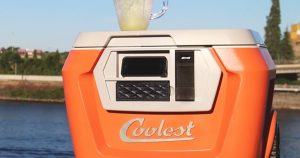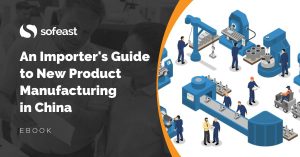A few years ago, I remember reading about the Coolest Cooler, a nice product that raised an amazing amount of money on Kickstarter: over 6,000 people bought it for a total of 13 million USD!! Yet, they went bust leaving a lot of frustrated backers and interested onlookers scratching their heads as to where it all went wrong for one of the most famous hardware startups of recent times and indeed the most funded Kickstarter campaign of 2014.
In this post, I’ll explore what went wrong for them and share my tips on how to avoid seven common pitfalls if you’re planning to produce your crowdfunded product in China and don’t want to end up like the Coolest Cooler.
The sad tale of the ‘Coolest Cooler’
Image credit: Coolest Cooler Kickstarter page
A relic of hardware startup history, the Coolest Cooler’s Kickstarter campaign page is still visible here, serving almost as a warning for today’s startups.
Despite the enormous interest and backing… they went bankrupt, as related by Geeky Gadgets:
The Coolest Cooler saga is one of the most detrimental projects to crowdfunding to ever grace Kickstarter, after raising more than $13 million from 62,642 backers and setting Kickstarter records at the time. The project and business has failed at nearly everything leaving 20,000 backers without a Coolest Cooler providing a fantastic legacy of how not to run a Kickstarter campaign.
The CEO wrote a long letter to the backers, including this sentence:
We learned a lot of lessons these past few years, and no doubt we made plenty of startup mistakes.
So, how can hardware startups avoid the 7 most common pitfalls?
In a nutshell, here are the seven lessons I am gathering from this case, based on a bit of research on the Internet and on some guesses on my own:
1. They probably went too early on Kickstarter
…and a lot of the preparation for manufacturing had not been done yet. (And yes, it costs money… but who said developing and making a new product was easy?)
2. Because of that lack of preparation, they weren’t clear on their readiness to manufacture
…and they simply kept discovering issues as they came up. If they had taken more time to mature their design, they might have decided to simplify their product (at least their version 1), to go to market faster and ensure they kept sufficient margin for themselves.
3. They probably got overly optimistic and unfounded timeline projections from their supplier.
Do not trust these! 99% of Chinese suppliers are very, very bad at planning.
4. They might well have chosen the wrong supplier
We have seen large and impressive industrial groups take years to develop a product, where a small and scrappy team can get to a good result in less than 6 months.
> Click here to get our free ebook on the topic of supplier selection which will help you find the right supplier.
5. They didn’t develop a backup supplier
…(which is a must for the funding they got and the volumes they expected) until too late in the process.
6. They probably didn’t set the right terms with the manufacturer at the start
…which would mean they didn’t have all the information in their hands (the list of components and their suppliers, the drawings, the schematics, and so on). As a result, ramping up a replacement supplier took them way longer than it should, as they had to start from scratch again. Read this series on manufacturing contracts, written by lawyer Steve Dickinson.
7. Their supplier might have acted unethically and raised pricing late in the game
…knowing full well that their customer was captive and had no plan B. I am mentioning it because it is very common.
*****
I don’t want to keep flogging a dead horse. The founders probably left some skin in this game. And thousands of people who “backed” them will be more careful with what they purchase on crowdfunding sites in the future. However, theirs is a cautionary tale that both hardware startups and backers can learn from even now.
Does this sound like a common issue for companies bringing a new product to life and relying on Chinese manufacturers? Any pitfalls I may have missed? Have you been stung when launching a new product, or did you manage to bring it to market successfully? Leave a comment and have your say.
Are you designing, or developing a new product that will be manufactured in China?
Sofeast has created An Importer’s Guide to New Product Manufacturing in China for entrepreneurs, hardware startups, and SMEs which gives you advance warning about the 3 most common pitfalls that can catch you out, and the best practices that the ‘large companies’ follow that YOU can adopt for a successful project.
It includes:
- The 3 deadly mistakes that will hurt your ability to manufacture a new product in China effectively
- Assessing if you’re China-ready
- How to define an informed strategy and a realistic plan
- How to structure your supply chain on a solid foundation
- How to set the right expectations from the start
- How to get the design and engineering right
Just hit the button below to get your copy (please note, this will direct you to my company Sofeast.com):



